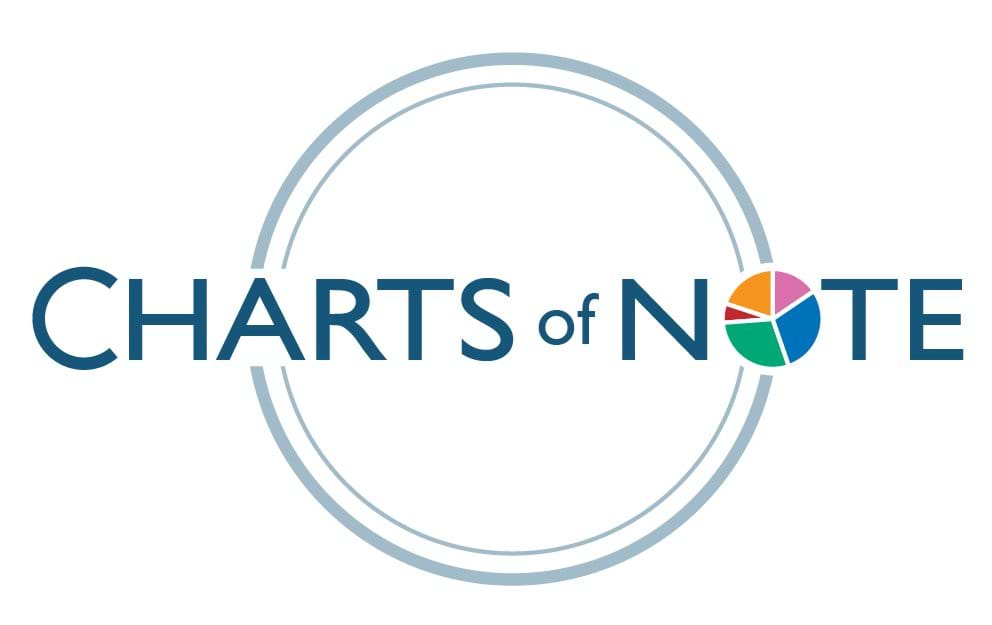ERS Charts of Note
Subscribe to get highlights from our current and past research, Monday through Friday, or see our privacy policy.
Get the latest charts via email, or on our mobile app for 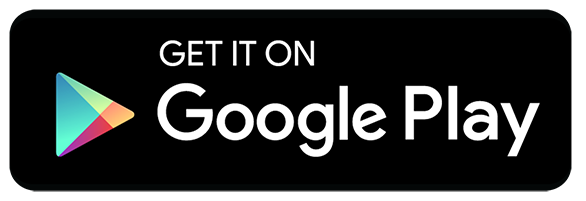 and
and 

Friday, April 23, 2021
Errata: On June 3, 2022, the text and chart notes were revised to correctly identify the Special Supplemental Nutrition Program for Women, Infants, and Children (WIC).
Spending on USDA’s food and nutrition assistance programs jumped 30 percent in fiscal year (FY) 2020 to an inflation-adjusted record of $122.1 billion, abruptly reversing a six-year decline. This increase reflects the expanded need for food assistance during the COVID-19 pandemic and the subsequent Federal response to meet that need. This response included USDA waivers allowing flexibility in the administration of the Department’s 15 existing food and nutrition assistance programs and the creation of two programs, Pandemic Electronic Benefit Transfer (P-EBT) and the Farmers to Families Food Box Program (Food Box Program). The rise in FY 2020 expenditures was driven by increased spending on these two new programs, as well as the Supplemental Nutrition Assistance Program (SNAP). Special Supplemental Nutrition Program for Women, Infants, and Children (WIC) expenditures remained relatively unchanged while pandemic-induced disruptions in the operation of schools, childcare centers and daycare homes led to declines in child nutrition spending. This chart is based on data available on the USDA, Economic Research Service’s (ERS) General Overview of Food Assistance and Nutrition Programs webpage, updated April 2021.
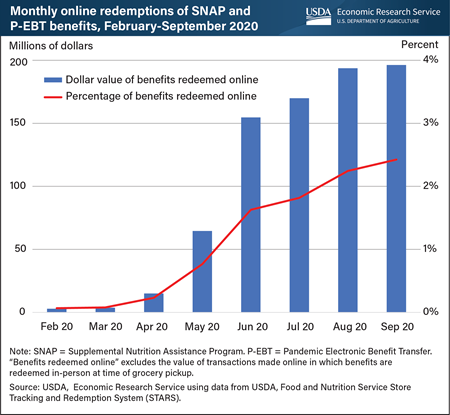
Friday, April 16, 2021
The Supplemental Nutrition Assistance Program (SNAP) Online Purchasing Pilot began in 2019 as mandated by the 2014 Farm Act and was quickly expanded in 2020 in response to the COVID-19 pandemic. The pilot allows households in participating States to use their SNAP benefits to purchase groceries online from a limited number of authorized retailers. Households can similarly use Pandemic Electronic Benefit Transfer (P-EBT) benefits, which were issued in 2020 to households with children missing free and reduced-price school meals during the pandemic. Online transactions using benefits are subject to the same requirements as in-person transactions and cannot be spent on tips or fees. The number of States where SNAP and P-EBT benefits could be redeemed online grew from just one State at the beginning of 2020 to 46 States by the end of September 2020. As availability increased and the pandemic necessitated continued social distancing, the value of SNAP and P-EBT benefits redeemed online increased. In February 2020, households redeemed less than $3 million in benefits online, accounting for less than 0.1 percent of all benefits redeemed. By September, this amount grew to $196 million — 67 times its value in February. Overall, households redeemed $801 million in benefits online from February to September 2020. Despite this rapid growth, online redemptions accounted for only 2.4 percent of all benefits redeemed in September. This chart is based on a chart in the USDA, Economic Research Service’s COVID-19 Working Paper: Supplemental Nutrition Assistance Program and Pandemic Electronic Benefit Transfer Redemptions during the Coronavirus Pandemic, released March 2021.

Thursday, April 8, 2021
The U.S. Government expanded existing food assistance programs and introduced new ones in response to the COVID-19 pandemic and subsequent economic contraction in the United States in 2020. Some States began issuing monthly supplemental emergency allotments to Supplemental Nutrition Assistance Program (SNAP) households in March 2020, with the rest beginning to do so in April 2020. All States issued Pandemic Electronic Benefit Transfer (P-EBT) benefits to households with children who missed free or reduced-price school meals during the 2019-20 school year; the earliest States began issuing P-EBT benefits in April 2020. This led to a rapid increase in the dollar amount of food assistance benefits issued to households and redeemed for groceries during the pandemic. The value of total monthly redemptions roughly doubled from $4.7 billion in March 2020 to $9.5 billion in June 2020. Most P-EBT benefits for the 2019-20 school year were issued in May and June 2020, leading total redemptions to peak in June and decline over the next three months. By September, redemptions amounted to $8.1 billion. Overall, an average of $8.4 billion per month in combined SNAP and P-EBT benefits were redeemed from April through September 2020—an increase of 74 percent compared with the average value of benefits redeemed during the same 6 months in 2017-19. This chart is based on a chart in the USDA, Economic Research Service’s COVID-19 Working Paper: Supplemental Nutrition Assistance Program and Pandemic Electronic Benefit Transfer Redemptions during the Coronavirus Pandemic, released March 2021.

Wednesday, March 10, 2021
Between 1999 and 2019, participation in USDA’s School Breakfast Program roughly doubled, increasing from 7.4 million children on a typical school day in fiscal year (FY) 1999 to 14.7 million in FY 2019. The Federal program makes healthy breakfasts available to all students in participating schools, with children from low-income households receiving the meals for free or at a reduced price. Most of the growth in participation over the last 2 decades has been among students receiving free breakfasts. Free breakfast participation rose from 5.7 million children in FY 1999 to 11.7 million in FY 2019, an increase of 5 million children. In FY 2019, 80 percent of breakfasts served were free, 5 percent were provided at a reduced price, and 15 percent were full price. Federal spending for the program totaled $4.5 billion in FY 2019—3 percent more than in the previous year. These data were collected before the COVID-19 pandemic and therefore do not account for pandemic-related conditions, including school closures and economic conditions. FY 2020 data that would reflect those circumstances are expected to be released during summer 2021. The data for this chart are from the USDA, Economic Research Service’s Child Nutrition Programs topic page.

Monday, October 19, 2020
In 2019, before the spring 2020 school closings in response to the COVID-19 pandemic, more than 29 million children participated in USDA’s National School Lunch Program (NSLP) and close to 15 million participated in the School Breakfast Program (SBP) on a typical school day. Children are certified to receive free or reduced-price meals — or they pay full price — based on their families’ incomes. Between 2009 and 2019, the number of children receiving free lunches was offset by a drop in reduced- and full-price meal participation. As a result, total NSLP participation declined by about 2 million, with free lunch participation making up 68 percent of total participation in 2019, compared with 52 percent in 2009. Over the same decade, free breakfast participation rose by 3.7 million and full-price breakfast participation rose by 0.2 million. This offset the 0.4-million decline in reduced-price breakfast participation, resulting in a 3.5-million increase in total SBP participation. In both 2009 and 2019, SBP served primarily students from low-income households, with 72 percent of participants receiving free breakfast in 2009 and 80 percent in 2019. This chart appears in “Free School Lunch, Breakfast Participation Rose Between 2009 and 2019” in the Economic Research Service’s Amber Waves magazine, October 2020.

Wednesday, September 23, 2020
In fiscal year (FY) 2019, USDA’s Child and Adult Care Food Program (CACFP) provided about 2 billion subsidized meals to children at child care centers and family day care homes, which accounted for 96 percent of all meals served in the program. Child care centers served 75 percent of CACFP meals in 2019. The program provided an additional 82 million meals to elderly and functionally impaired adults at adult day care centers. The number of CACFP meals served in family day care homes has dropped from a high of 777 million in FY 1996 to 435 million in FY 2019, while the number of meals served in child care centers has grown from 746 million to 1.5 billion over that same time period. USDA’s costs for CACFP in FY 2019 totaled $3.7 billion. Meals and snacks served to CACFP participants must meet USDA nutrition standards to receive Federal reimbursements. Closures of many child and adult care facilities due to the COVID-19 pandemic are reflected in fewer CACFP meals served in April 2020 compared with April 2019. Preliminary data from USDA’s Food and Nutrition Service record 125 million meals served in April 2020, down from 194 million meals a year earlier. Waivers to program regulations granted by USDA in March 2020 allowed providers to distribute CACFP meals as “grab and go” or via delivery. This chart appears in the Economic Research Service report, The Food Assistance Landscape: Fiscal Year 2019 Annual Report, July 2020.
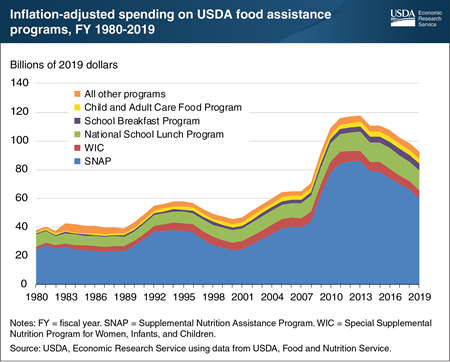
Friday, August 21, 2020
USDA administers 15 domestic food and nutrition assistance programs that together form a nutritional safety net for millions of children and low-income adults. Federal expenditures on these programs totaled $92.4 billion in fiscal year (FY) 2019, their lowest level since FY 2009 and 22 percent less than the inflation-adjusted historical high of $117.9 billion set in FY 2013. The decline in spending between 2013 and 2019 was likely largely due to continued improvement in the U.S. economy, as the unemployment rate declined from 7.4 to 3.7 percent over that time period. Spending for the Supplemental Nutrition Assistance Program (SNAP), which accounted for almost two-thirds (65.3 percent) of Federal food and nutrition assistance spending in FY 2019, totaled $60.4 billion, or 8 percent less than in FY 2018 and 30 percent less than the inflation-adjusted historical high of $86.3 billion set in FY 2013. Expenditures fell for both SNAP and the Special Supplemental Nutrition Program for Women, Infants, and Children (WIC) between FYs 2018 and 2019, but increased between 2 and 3 percent for each of the three largest child nutrition programs—the National School Lunch Program, the School Breakfast Program, and the Child and Adult Care Food Program. A version of this chart appears in the Economic Research Service report, The Food Assistance Landscape: Fiscal Year 2019 Annual Report, July 2020.
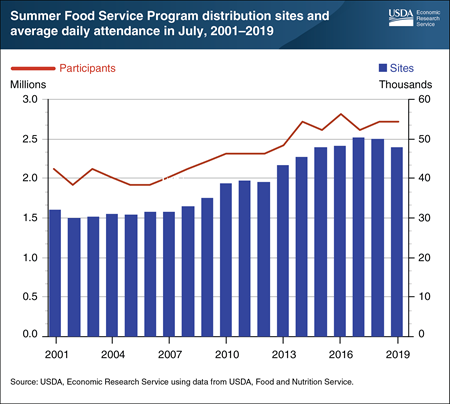
Thursday, June 11, 2020
In 2019, USDA’s Summer Food Service Program (SFSP) provided free USDA-funded meals to approximately 2.7 million children on a typical day in July, the program’s peak month. SFSP meals were served at 47,463 USDA-approved sites. Schools, libraries, camps, playgrounds, housing projects, community centers, churches, and other public locations where children gather in the summer all qualify as USDA-approved sites. “Open sites” operate in areas where at least half of the children come from families with incomes at or below 185 percent of the Federal poverty level. They serve any child who comes to the site, with no requirement for preregistration or income determination. SFSP also operates in “closed sites” that serve enrolled children. Closed sites do not have to be located in low-income areas, but they have to primarily serve low-income children: at least half of the children at the site must be from households with incomes at or below the SFSP threshold. In spring 2020, most American schools closed unexpectedly because of the COVID-19 pandemic. To replace school meals, many school districts began providing meals to children under the SFSP, and USDA removed the requirement that open sites operate in low-income areas. USDA addressed concerns created by the pandemic by granting waivers that allowed SFSP sites to distribute “grab and go” meals rather than requiring meals be eaten onsite, to provide meals for multiple days at one time, and to allow parents to pick-up meals for their children. As of June 1, 2020, these waivers remain in effect until August 31, 2020. States may also apply to participate in USDA’s Pandemic EBT (electronic benefits transfer) program. This program provides children who normally receive free or reduced-price school meals with food purchasing benefits equivalent to the value of the meals they would have received if schools were open. A version of this chart appears in the Child Nutrition Programs: Charts topic page on the ERS website.

Wednesday, August 28, 2019
On a typical school day in fiscal year 2018, 29.7 million children participated in USDA’s National School Lunch Program (NSLP), and USDA expenditures on the program totaled $13.8 billion for the year. These expenditures include cash reimbursements for meals served and the value of foods provided to schools by USDA. In return for the reimbursements and donated foods, schools must serve lunches that meet Federal nutrition requirements and offer these lunches to children from low-income families for free or at a reduced-price. Almost three-quarters (74 percent) of lunches were provided for free or at a reduced-price in 2018. Since 2001, free lunch participation has increased every year, from 12.9 million children in 2001 to 20.2 million in 2018. Over the same period, full-price lunch participation peaked at 12.6 million children in 2007, and reduced-price meal participation peaked at 3.2 million in 2009. Through 2011, overall NSLP participation increased, reaching a high of 31.8 million children, driven by growth in free-meal participation. Since then, declining participation of children receiving reduced- and full-price lunches has led to a drop in overall participation. A longer version of this chart (starting in 1970) appears in the Child Nutrition Programs: Charts topic page on the ERS website.
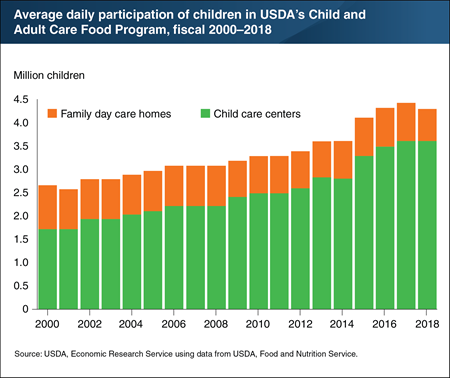
Friday, August 2, 2019
On a typical day in fiscal year 2018, USDA’s Child and Adult Care Food Program (CACFP) provided subsidized meals and snacks to more than 4.3 million children at child care centers and family day care homes. Participation in CACFP through child care centers has grown from 1.7 million children in 2000 to 3.6 million in 2018, while participation through family day care homes has dropped from 1 million children in 2000 to fewer than 800,000 in 2018. The rise in center-based participation more than offset the decline in home-based participation through 2017, resulting in participation in CACFP increasing from 2.7 million children in 2000 to 4.4 million in 2017. The number of children attending centers who participated in the program in 2018 was the same as in 2017, but fewer children in day care homes participated. The program also provided subsidized meals for 131,634 older or functionally impaired adults at adult day care centers in 2018. Meals and snacks served to CACFP participants must meet USDA nutrition standards to receive Federal reimbursements. USDA’s costs for CACFP in fiscal 2018 totaled $3.6 billion. This chart appears on the chart page of ERS’s Child Nutrition Programs topic page.
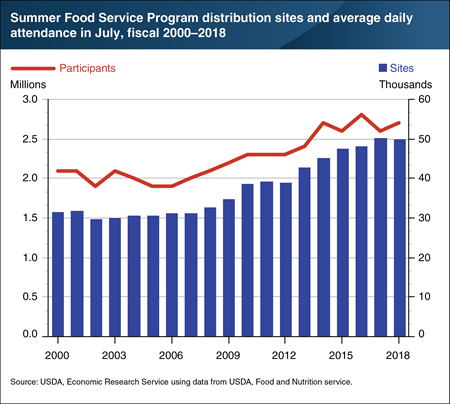
Friday, July 5, 2019
In 2018, USDA’s Summer Food Service Program provided meals to approximately 2.7 million children on an average operating day in July, the peak month for program operations. Meals were served at 49,795 USDA-approved sites. These sites are eligible to offer free USDA-funded meals and snacks if the sites operate in areas where at least half of the children come from families with incomes at or below 185 percent of the Federal poverty level, or if more than half of the children served by the site meet this income criterion. Schools, libraries, camps, parks, playgrounds, housing projects, community centers, churches, and other public locations where children gather in the summer all qualify as USDA-approved sites. Enrichment activities are often offered along with the meals and snacks. Many low-income children also obtain free meals while school is out through the Seamless Summer Option of the National School Lunch and Breakfast Programs. This chart is from the Child Nutrition Programs: Charts topic page on the ERS website, updated in June 2019.
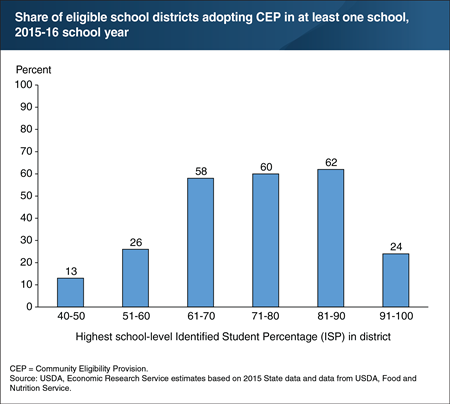
Thursday, September 20, 2018
The Community Eligibility Provision (CEP) allows eligible schools in high-poverty areas to offer free USDA school meals to all students. Eligibility to use CEP is based on the share of students participating in specified income-based assistance programs—known as the Identified Student Percentage (ISP). Schools are eligible to use CEP if the ISP for the school, group of schools, or district is at least 40 percent. ERS researchers used administrative data from USDA and States for the 2015-16 school year to group eligible school districts into categories based on the highest school-level ISP in the district. The researchers found that more than half of districts with schools in ISP ranges between 61 and 90 percent used CEP in at least one of their schools. Under CEP, USDA reimburses schools at the higher free-meal rates for a portion of the meals served, and the remaining meals are reimbursed at the lower paid-meal rates. At ISP levels above 62.5 percent, all meals are reimbursed at the free rates. This reimbursement schedule likely contributes to districts with schools with higher needs making greater use of CEP. However, districts that have schools with ISP levels of 91-100 percent had a lower CEP adoption rate. Some districts may have felt less need to adopt CEP because so many children’s eligibility for free meals was already established through participation in other programs. This chart appears in “High-Poverty Schools Are More Likely To Adopt the Community Eligibility Provision of the USDA School Meal Programs” in the September 2018 issue of ERS’s Amber Waves magazine.

Wednesday, August 29, 2018
The Community Eligibility Provision (CEP) of USDA’s National School Lunch Program allows eligible schools in high poverty areas to offer USDA school meals at no charge to all students. CEP reduces the administrative burden associated with collecting paper applications and meal payments from students. Eligibility to use CEP is based on the share of students participating in USDA’s Supplemental Nutrition Assistance Program (SNAP) or other specific income-based assistance programs—known as the Identified Student Percentage (ISP). Schools are eligible to use CEP if the ISP for the school, group of schools, or district is at least 40 percent. USDA reimburses schools for meals according to a formula based on the ISP. Following a 3-year phase-in during which CEP was only available in a limited number of States, the provision was offered to all eligible school districts in the 2014-15 school year. Thirty-two percent of eligible districts used CEP in at least one of their schools in 2014-15, 37 percent in 2015-16, and 47 percent in 2016-17. A recent ERS study found that use of CEP was generally higher for poorer districts, districts in States that were part of the phase-in period, and schools in the Southeast. The data for this chart are from the ERS report, Characteristics of School Districts Offering Free School Meals to All Students Through the Community Eligibility Provision of the National School Lunch Program, released on August 28, 2018.
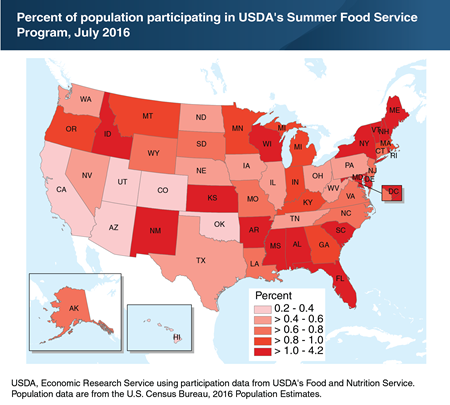
Tuesday, July 10, 2018
When school is not in session, USDA’s Summer Food Service Program (SFSP) provides free meals and snacks to children and teens at approved sites such as schools, churches, parks, community centers, and day camp programs. SFSP meals must meet Federal nutrition guidelines and are served in areas with high concentrations of low-income children. In July 2016, the percent of a State’s total population participating in SFSP ranged from 0.2 percent in Arizona to 2.1 percent in New York. That same year, 4.2 percent of the District of Columbia’s population participated in the program. Demographic factors help explain differences in program participation as a percentage of total population; higher SFSP participation rates could reflect a higher proportion of school-age children relative to total population or a higher number of low-income children relative to the overall school-age population. Differences in availability and accessibility of SFSP sites also play an important role in the variability across States. Many low-income children also obtain free meals while school is out through the Seamless Summer Option of the National School Lunch Program and the School Breakfast Program, not included in this map. This chart appears in the ERS topic page Summer Food Service Program, updated June 19, 2018.
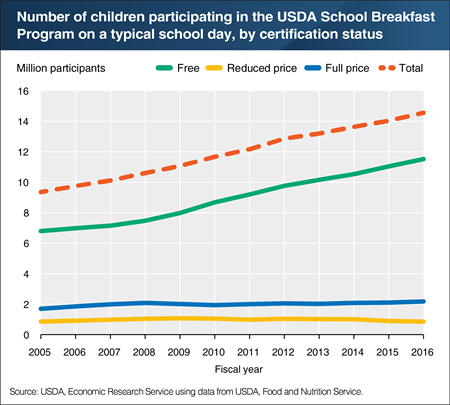
Monday, November 6, 2017
USDA’s School Breakfast Program makes healthy breakfasts available to all students in participating schools, with children from low-income households receiving the meals for free or at a reduced price. The program has grown considerably in the past 11 years, with participation increasing from 9.4 million children on a typical school day in fiscal 2005 to 14.6 million in fiscal 2016, an increase of 5.2 million children daily. Most of that growth in participation has been among students qualified to receive free breakfasts. Free breakfast participation rose from 6.8 million children in fiscal 2005 to 11.5 million in fiscal 2016, an increase of 4.7 million children. In fiscal 2016, 79 percent of breakfasts served were free, 6 percent were provided at a reduced price, and 15 percent were full price. Federal spending for the program totaled $4.2 billion in fiscal 2016—an increase of 7 percent over fiscal 2015. The data for this chart are from the Child Nutrition Programs topic page on the ERS Web site, updated October 2017.
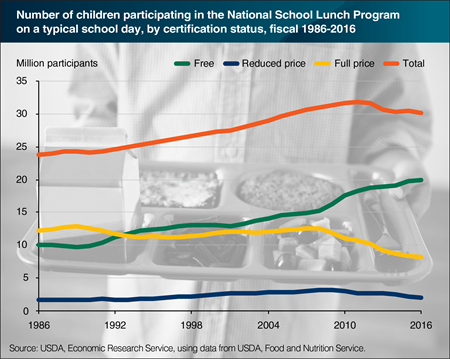
Tuesday, October 10, 2017
On a typical school day in fiscal 2016, 30.4 million children participated in USDA’s National School Lunch Program and 73 percent of them received the meals for free or at a reduced price. The number of students receiving free and reduced-price lunches has grown from 18.5 million in 2008 to 22.1 million in 2016. Some of this increase may be attributable to the 2007-09 recession and the slow recovery that followed. Declining incomes likely led more families to qualify and/or apply for free or reduced-price lunches. In addition, since 2014, the Community Eligibility Provision of the Healthy, Hunger-Free Kids Act has made it possible for more schools to offer free meals to all their students. Between 2008 and 2011, the increase in free and reduced price participation more than offset the decline in full-price participation, with total participation increasing from 31.0 million to 31.8 million children daily. After 2011, however, declining full-price participation resulted in total daily participation falling. This chart appears in the Child Nutrition Programs topic page on the ERS Web site, updated on October 2, 2017.
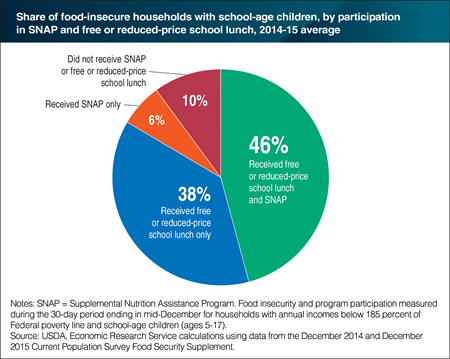
Monday, August 21, 2017
As summer comes to a close, kids head back to school. For many low-income children and teens, returning to school also means returning to free or reduced-price lunches provided through USDA’s National School Lunch Program (NSLP). In September 2016, 21.9 million children received free or reduced-price school lunches, including children who lived in food-insecure households—households that at times have difficulty putting enough food on the table due to limited resources. In 2015, 13.1 million children lived in food-insecure households. In 2014 and 2015, 84 percent of low-income food-insecure households with school-age children accessed free or reduced-price lunches through the NSLP, either in combination with Supplemental Nutrition Assistance Program (SNAP) benefits (46 percent), which provide food and nutrition assistance to low-income Americans, or alone (38 percent). An estimated 6 percent of low-income food-insecure households with school-age children received SNAP, but not free or reduced-price school lunches, and 10 percent did not participate in either program. This chart appears in "USDA’s National School Lunch Program Reduces Food Insecurity" in the August 2017 issue of ERS’s Amber Waves magazine.
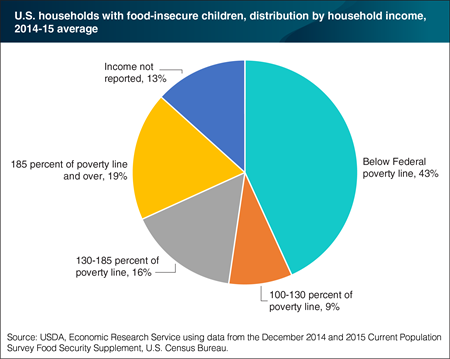
Wednesday, July 26, 2017
In 2014-15, 17.9 percent of U.S. households with children under the age of 18 were food insecure—they had difficulty putting enough food on the table for all their members. In about half of these households (8.6 percent of U.S. households with children), children were food insecure and experienced reduced dietary quality and food intake. Food insecurity is closely related to income as poor households are more likely to experience food insecurity. In 2014-15, 43 percent of households with food-insecure children had incomes below the Federal poverty line and one-quarter had incomes between the poverty line and 185 percent of the poverty line. Households with incomes below 185 percent of the poverty line may be eligible for programs like the free- or reduced-price National School Lunch Program. An ERS review of scientific research studies shows that participation in USDA school meals reduces food insecurity. However, about 19 percent of households with food-insecure children in 2014-15 may have been ineligible for such assistance. The data for this chart appear in the ERS report, Children’s Food Security and USDA Child Nutrition Programs, released on June 20, 2017.
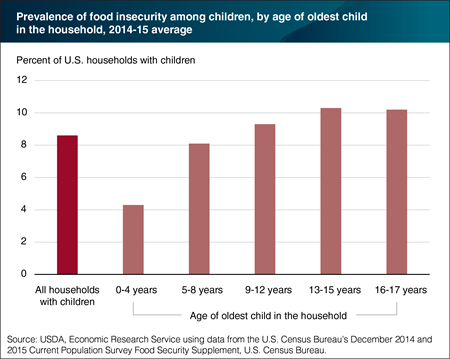
Wednesday, June 21, 2017
Each year a portion of American households are food insecure—they struggle to afford enough food for all household members. In some of these households, children—along with adults—experience reductions in dietary quality and food intake. In 2014-15, children were food insecure in 8.6 percent of all U.S. households with children. Households that only included young children (0 to 4 years) had a lower prevalence of child food insecurity (4.3 percent) than those that included school-age children (8.1 to 10.3 percent depending on the age of the oldest child in the household). USDA child nutrition programs, such as WIC, the National School Lunch Program, and the School Breakfast Program, can be important sources of nutritious foods and meals for food-insecure children. A review of a number of scientific research studies shows that participation in USDA school meals reduces food insecurity and has positive effects on diet for those that do experience food insecurity. The data for this chart appear in the ERS report, Children’s Food Security and USDA Child Nutrition Programs, released on June 20, 2017.
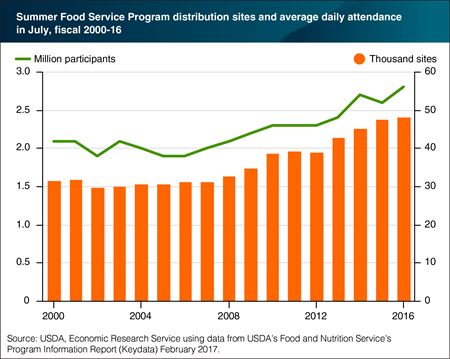
Thursday, June 8, 2017
In 2016, USDA’s Summer Food Service Program provided meals to 2.8 million children on an average operating day in July, the peak month for program operations. This was a 7.7-percent increase from 2015’s July participation. Meals are served at a wide variety of USDA-approved sites including schools, camps, parks, playgrounds, housing projects, community centers, churches, and other public sites where children gather in the summer. Sites are eligible to offer free USDA-funded meals and snacks if the sites operate in areas where at least half of the children come from families with incomes at or below 185 percent of the Federal poverty level, or if more than half of the children served by the site meet this income criterion. In 2016, 47,981 sites offered summer meals, about 400 more than in 2015. Many low-income children also obtain free meals while school is out through the Seamless Summer Option of the National School Lunch and Breakfast Programs. This chart is from the Child Nutrition Programs: Summer Food Service Program topic page on the ERS Web site, updated May 22, 2017.


